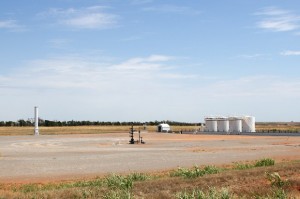Oklahoma’s Largest Earthquake ‘Potentially Triggered’ by Smaller Disposal Well Quake, New Study Suggests
-
Joe Wertz

Joe Wertz / StateImpact Oklahoma
A waste fluid disposal well in western Oklahoma.
Oil and gas industry-related waste water injection may have triggered a cascading sequence of earthquakes that culminated in Oklahoma’s largest earthquake ever recorded, the 5.7-magnitude temblor that struck near Prague in November 2011, a new peer-reviewed paper published in the Journal of Geophysical Research suggests.
If true, Oklahoma’s November 2011 earthquake — which injured two people and damaged more than a dozen homes — could be the most powerful earthquake associated with waste water injection, the USGS said in a statement about the research:
The research published this week suggests that the foreshock, by increasing stresses where M5.7 mainshock ruptured, may have triggered the mainshock, which in turn, triggered thousands of aftershocks along the Wilzetta fault system, including a M5.0 aftershock on November 8, 2011.
The paper, “Observations of Static Coulomb Stress Triggering of the November 2011 M5.7 Oklahoma Earthquake Sequence,” was written by Danielle Sumy at the University of Southern California and researchers at the U.S. Geological Survey, Cornell, Brown and Columbia universities, and was published on March 7.
One of the study’s co-authors, Cornell’s Katie Keranen, wrote a March 2013 paper in Geology that also linked oil and gas disposal wells to the Prague earthquake. Other peer-reviewed research has linked earthquakes in Oklahoma and other states to oil and gas.
The epicenters of the November 2011 earthquakes were located near disposal wells, but proximity alone isn’t enough to make the link: About 80 percent of the state is located within 9 miles of one of Oklahoma’s 4,000 active disposal wells, according to the Oklahoma Geological Survey. In the new study, the researchers modeled the stresses of the Wilzetta fault line near Prague and concluded that the manner in which the quake sequence progressed and the shallow depth of the quakes, when combined with proximity to disposal wells, points to fluid injection.
“The observation that a human-induced earthquake can trigger a cascade of earthquakes, including a larger one, has important implications for reducing the seismic risk from wastewater injection,” USGS seismologist and study co-author Elizabeth Cochran said in a statement about the research.
Oklahoma has experienced an exponential increase in earthquakes, which many federal and university researchers think is likely linked to disposal wells oil and gas operators use for waste fluid disposal. This waste fluid is produced by hydraulic fracturing — “fracking” — and other types of drilling. Operators inject the waste into the wells, where it’s stored deep underground and away from water supplies.
Other states like Arkansas, Colorado, Ohio and Texas have experienced earthquakes linked to disposal wells, and most have passed rules or laws that address the risk to public safety. No such rules are being considered in Oklahoma, but in September 2013 the Corporation Commission, the state’s oil and gas regulator, ordered a disposal well operator in south-central Oklahoma to reduce the pressure and volume of waste fluid injection after a swarm of earthquakes struck near Marietta in Love County.
The Corporation Commission on Thursday will consider new rules that would require operators of some disposal operators to capture more pressure and volume measurements — data researchers say are vital to studying the issue.
